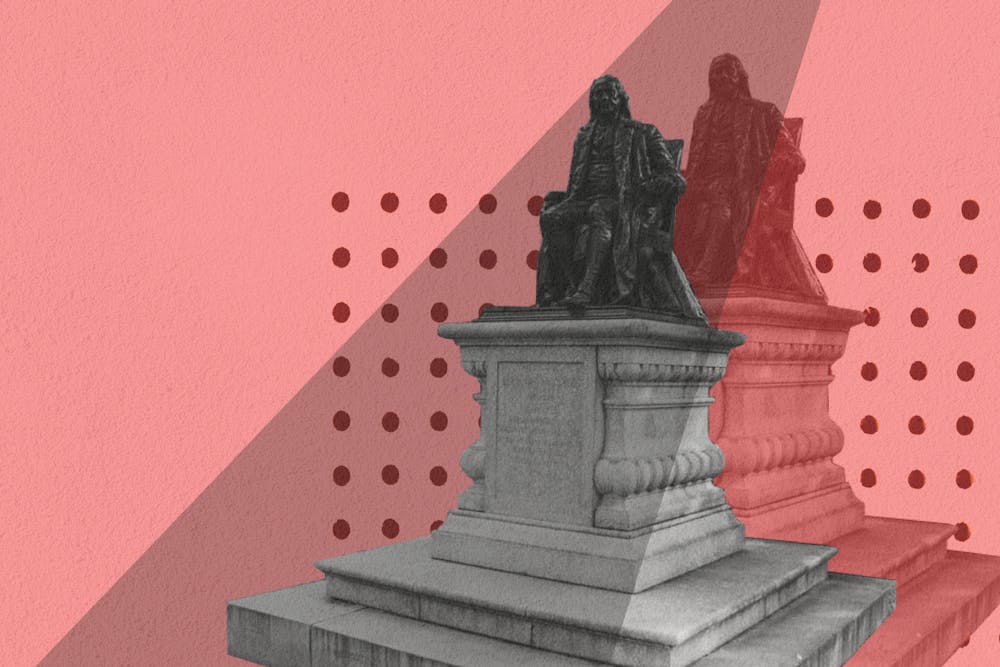“What does it look like to attempt to decolonize design for an app?” Malkia Okech (C '19) asks. “What does it mean to create an immersive digital experience about slavery when that is just such a traumatizing history?”
The Penn & Slavery Project, an undergraduate–founded collective dedicated to researching the University’s relationship to Black histories, took these questions and many more into account when creating the augmented reality app. As a student designer, Malkia worked with peers and faculty members to cultivate an immersive experience that educates users on Penn’s deeply rooted ties to slavery, race science, and anti–Blackness.
Malkia often refers to the free app as “an admissions tour turned upside down.” With six stops across campus including at the Penn Museum and the Quad, users can embark on a digital and critical exploration of Penn from anywhere in the world. Each location has been intentionally chosen and transformed using augmented reality to parse through Penn’s connections to slavery. The tour's goal is to explain how the University’s history has impacted the campus we know today, the city of Philadelphia, and the country at large.
For example, at the Class of 1949 Generational Bridge, the history of Breanna Moore’s family across five generations is told using her grandmother’s quilt. “There’s so much symbolism about how quilts hold generations of stories. It tells the story of her own family in relation to the violence at Penn,” says VanJessica Gladney, who is an original Student Researcher and Fellow for the Project as well as a second–year history Ph.D. candidate. The virtual location of the legacy–filled quilt underscores the importance of shallow historical recognition. It forces app users to think critically by juxtaposing Breanna's family against wealthy alumni donors.
Founded around the time that many universities were considering renaming buildings due to their namesakes’ ties to slavery, the Penn & Slavery Project hoped to encourage Penn to hop on the bandwagon of taking ownership for the past. Despite this, Penn formally denied any connection to slavery in 2016, motivating the Penn & Slavery Project to dive deeper into research to expose how inaccurate this recounting of history was.
To ensure the information had a wide–reaching impact, one of the team’s most critical concerns when constructing the app was to make sure it was accessible, approachable, and understandable. By choosing to make the app remotely operable rather than using touch–points on campus that must be scanned through the app, the Penn & Slavery Project made the tour accessible to all individuals no matter their location.
Including closed captions and trigger warnings were other methods that the team employed to keep the app safe and educational. The app format itself is more conducive to an encouraging learning experience, VanJessica believes, as it doesn’t presume background knowledge, and allows users to learn at their own pace in a manner much more approachable than an academic paper.
Alongside raising awareness in an educational and accessible fashion, the Penn & Slavery Project has another hope for the app’s impact: “I think our overall goal is that this will help encourage Penn to start taking reparative actions,” VanJessica says. The Project believes that Penn should consider giving Black community members monetary reparations, and hopes that the app will put pressure on the administration to do so.
When designing the app, many discussions about aesthetics and their associated meanings took place. In order to avoid playing into common western hegemonic design tropes, student designers spent time reading, learning, and researching alternate approaches. “I did some research on designers who were combatting racism, or were just telling people they need to breach the colonial mindset that tells us we should be afraid of color,” Malkia said. “I encouraged the team to think outside of that and look at African patterns and tapestry, and think about how we could make the look and feel of the app a little more inviting to contrast the information.”
At the beginning of the app design process, early frames involved a very limited and dull color palette of grey and tan that cast the app in historically grave light. Malkia pointed out that this tendency to portray the past in such a subdued manner is a result of domineering design narratives that have shut out the vibrant hues and eccentric patterns traditional to African design. The team made a conscious effort to flip this script through its design choices.
The Penn & Slavery Project’s augmented reality app is an interactive example of interdisciplinary collaboration. With students pursuing degrees in everything from computer science to English, the Project’s emphasis on digital history unites their respective academic communities. Digital history is an emerging field that capitalizes on the “moldable, fluid, and dynamic” nature of technology to understand the past, attracting students from a variety of academic backgrounds. Despite having vastly different educational pursuits, the team is united by their passion for exposing buried truths about the University’s history, seeking justice for modern–day Black communities, and educating the masses in an approachable yet innovative way.







